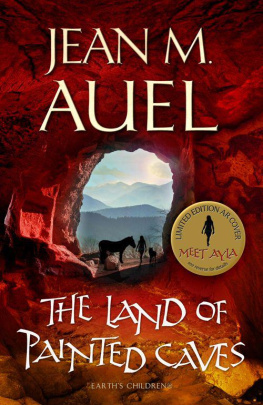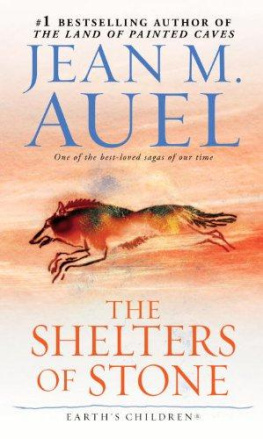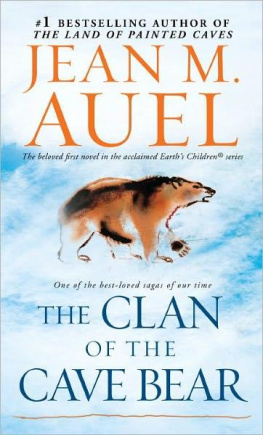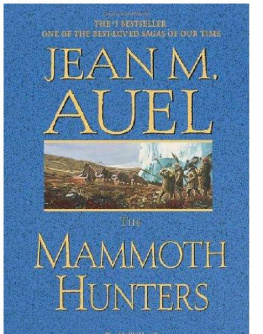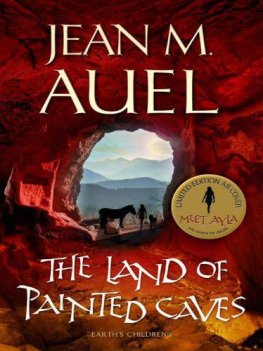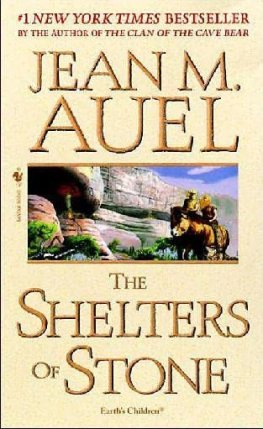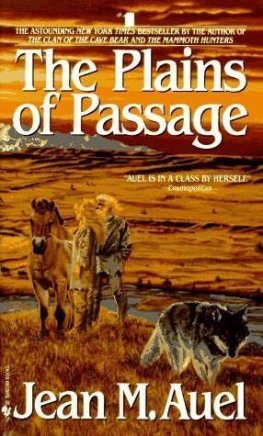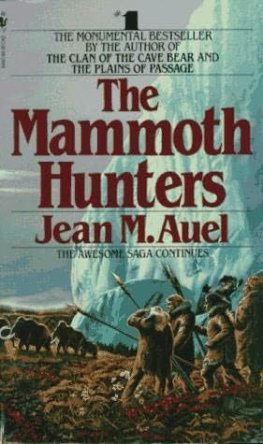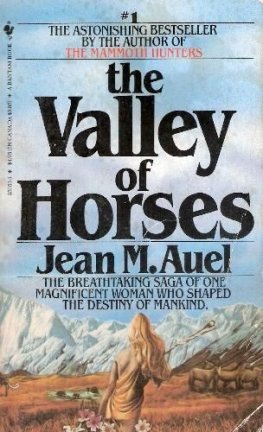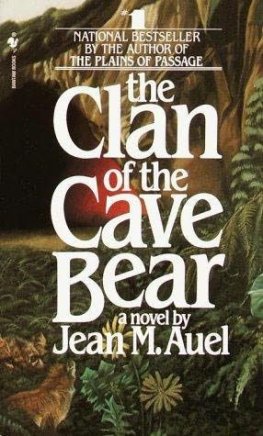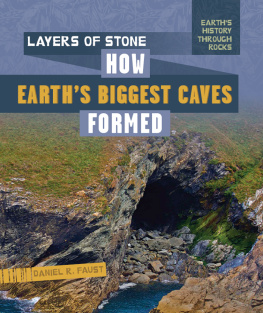CONTENTS
The Land of Painted Caves
Jean M Auel

www.hodder.co.uk
Also by Jean M. Auel
The Clan of the Cave Bear
The Valley of Horses
The Mammoth Hunters
The Plains of Passage
The Shelters of Stone
First published in Great Britain in 2011 by Hodder & Stoughton
An Hachette UK company
Copyright (c) 2010 by Jean M. Auel
The right of Jean M. Auel to be identified as the
Author of the Work has been asserted by her in accordance
with the Copyright, Designs and Patents Act 1988.
Earth's Children(r) is a trademark of Jean M. Auel
All rights reserved. No part of this publication may be reproduced, stored
in a retrieval system, or transmitted, in any form or by any means without
the prior written permission of the publisher, nor be otherwise circulated
in any form of binding or cover other than that in which it is published and
without a similar condition being imposed on the subsequent purchaser.
All characters in this publication are fictitious and any resemblance
to real persons, living or dead, is purely coincidental.
A CIP catalogue record for this title is available from the British Library
Epub ISBN 9781444720587
Book ISBN 9780340824252
Hodder & Stoughton
338 Euston Road
London NW1 3BH
www.hodder.co.uk
DEDICATION
For RAEANN
First born, last cited, always loved,
and for FRANK,
who stands by her side,
and for AMELIA and BRET, ALECIA, and EMORY,
fine young adults,
with love
Acknowledgments
I am grateful for the assistance of many people who have helped me to write the Earth's Children(r) series. I want to thank again two French archaeologists who have been particularly helpful over the years, Dr. Jean-Philippe Rigaud and Dr. Jean Clottes. They have both enabled me to understand the background and to visualise the prehistoric setting of these books.
Dr. Rigaud's help has been invaluable beginning with my first research visit to France, and his assistance has continued over the years. I particularly enjoyed the visit, which he arranged, to a stone shelter in Gorge d'Enfer, which is still much the way it was in the Ice Age: a deep protected space, open in the front, with a level floor, a rock ceiling and a natural spring at the back. It was easy to see how it could be made into a comfortable place to live. And I appreciated his willingness to explain to reporters and other media people from many countries the interesting and important information about some of the prehistoric sites in and around Les Eyzies de Tayac when Book , The Shelters of Stone , was launched internationally from that location in France.
I am also most grateful to Dr. Jean Clottes, who arranged for Ray and me to visit many remarkable painted caves in the south of France. Particularly memorable was the visit to the caves on the property of Comte Robert Begouen in the Volp Valley - l'Enlene, Trois-Freres, and Tuc-d'Audoubert - whose art is often pictured in texts and art books. To actually see some of that remarkable art in its environment, escorted by both Dr. Clottes and Count Begouen, was a treasured experience, and for that thanks in great measure are also due to Robert Begouen. It was his grandfather and two brothers who first explored the caves and began the practice of maintaining them, which continues to this day. No one visits the caves without the permission of Count Begouen, and usually his accompaniment.
We visited many more caves with Dr. Clottes, including Gargas, which is one of my favourites. With its many handprints, including those of a child, and the niche, large enough for an adult to enter, whose inner rock walls are completely covered with a rich red paint using the ochres from the region, I am convinced Gargas is a woman's cave. It feels like the womb of the earth. Above all, I am grateful to Jean Clottes for the visit to the extraordinary Grotte Chauvet. Even though he became too ill with the flu to accompany us, Dr. Clottes arranged for Jean-Marie Chauvet, the man who discovered it and for whom it was named, and Dominique Baffier, curator of Grotte Chauvet, to show us that remarkable site. A young man who was working at the site was also with us and helped me through some of the more difficult parts.
It was a deeply moving experience that I will never forget and I am grateful to both M. Chauvet and Dr. Baffier for their clear and astute explanations. We went in through the ceiling, much enlarged since M. Chauvet and his colleagues first found their way in, and down a ladder that was attached to the rock wall - the original entrance was closed by a landslide many thousands of years ago. They explained some of the changes that have occurred during the past 35,000 years since the first artists made their magnificent paintings.
In addition, I would like to thank Nicholas Conard, an American who lives in Germany and is in charge of the Archaeology Department at the University in Tubingen, for the opportunity to visit several of the Caves along the Danube in that region of Germany. He also showed us several of the ancient carved ivory artifacts that are more than thirty thousand years old, including mammoths, a graceful flying bird that he found in two parts several years apart, and a most amazing lion-human figure. His latest find is a female figure that was created in the same style as others from France, Spain, Austria, Germany, the Czech Republic from the same era, but that is unique in its execution.
I also want to thank Dr. Lawrence Guy Strauss, who has been so willing and helpful in arranging for visits to sites and caves and often accompanying us on several trips to Europe. There were many highlights during those trips, but one of the most interesting was the visit to Abrigo do Lagar Velho, Portugal, the site of the 'lapedo valley child', whose skeleton showed evidence that contact between Neanderthals and anatomically modern humans resulted in interbreeding. The discussions with Dr. Strauss about those Ice Age humans were not only informative, but always fascinating.
I have had discussions and asked questions of many other archaeologists, palaeanthropologists and specialists that I have met, about that particular time in our prehistory, when for many thousands of years both kinds of humans occupied Europe at the same time. I have appreciated their willingness to answer questions and discuss the several possibilities of how they lived.
I want to give special thanks to the French Ministry of Culture for the publication of a book, which I found invaluable: L'Art des Cavernes: Atlas des Grottes Ornees Paleolithiques Francaises , Paris, 1984 , Ministere de la Culture. It contains very complete descriptions, including the floor plans, photographs, and drawings, as well as an explanatory narrative of most of the known painted and engraved caves in France, as of 1984 . It does not include Cosquer, whose entrance is below the surface of the Mediterranean, or Chauvet, neither of which were discovered until after 1990 .
I have visited many caves, so many times, and I can remember the ambiance, the mood, the feeling of seeing exceptional art painted on the walls inside caves, but I couldn't recall precisely what the first figure was, or on which wall it appeared, how far into the cave it was, or what direction it was facing. This book gave me the answers. The only problem was that it was published in French, of course, and while I have learned some French over the years, my command of the language is far from adequate.
So I am deeply indebted to my friend, Claudine Fisher, Honorary French Consul for Oregon, French Professor and Director of Canadian Studies at Portland State University. She is a native speaker who was born in France and she translated all the information I needed of every cave I wanted. It was a lot of work, but without her help, I could not have written this book, and I am more grateful than I can begin to express. She has been helpful in many other ways, too, besides just being a good friend.

